 |
 |
 |
| |
IMPACT OF NEW DAA-CONTAINING REGIMENS ON HCV TRANSMISSION AMONG INJECTING DRUG USERS (IDUS): A MODEL-BASED ANALYSIS (ANRS 12376)...."Test & Treat", Eliminating HCV
|
| |
| |
Reported by Jules Levin
EASL 2014 April 9-13 London, UK
"Test & Treat"
from Jules: these researchers "assessed the impact of interventions at different levels of the cascade of care on prevalence and incidence of the disease in a French IDU population". They considered interventions: improved testing, linkage-to-care, adherence & importantly allowing patients to be treated sooner at F0 rather than having to wait until they were F2. In the USA where at this time we do not restrict the initiation of treatment to patients to only F2 disease this impediment would not be of concern. So this model, which is similar to the model I designed for a large NYC-based HCV screening project, suggests "Treatment as Prevention" for IDUs could significantly reduce, perhaps eliminate HCV, end HCV, as a contagious disease among the IDU community, but also contribute to eliminating HCV all together, if all the stakeholders can come together to collaborate. HCV could in theory be eliminated. The development of these new DAA therapy regimens is the greatest medical breakthrough in 40 years or longer because for the first time in history we can cure/eliminate a "virus" from a person with time-limited therapy & it is short-term, only 12 or less weeks. This has never been accomplished before, HIV is lifetime therapy. HAART costs about $15,000 a year plus labs etc. For one 30 year old person who gets infected over the course of a 40 year lifespan the total costs could be over $600,000. Curing/eliminating HCV could save a lot of resources & money. It is estimated that direct costs associated with chronic HCV are considerable, averaging over $24,000 annually for all patients and $60,000 for those with advanced liver disease, the total burden & costs on our healthcare system are expected to increase as illuminated in these recently published studies:........http://www.natap.org/2012/HCV/040412_02.htm......
http://www.natap.org/2013/HCV/010713_01.htm.......
http://www.natap.org/2012/HCV/120312_01.htm
Eliminating HCV includes proper implementation of an effective comprehensive system of testing & care "Test & Treat" for IDUs and marginalized hard-to-treat patient populations.
You can see from the 2 Results slides below prevalence goes down immediately just a little as soon as incoming DAA regimens are used, and prevalence decreases only ever so slightly over several years with improved testing & linkage-to-care & adherence, although incidence does not improve, BUT after treatment access improves to F0 patients instead of having to wait until F2 AND when you combine this with improved testing, linkage-t0-care & adherence THEN you see significant improvements in transmission rates and complications of cirrhosis.
The HCV screening model I designed several years ago before telaprevir & boceprevir were FDA approved & for which I raised $2 million funding to implement, is similar to the intervention model used by these researchers, as well I designed a patient navigator system as an important part of the intervention model. Unfortunately I turned over the implementation of this project to NYC and they did not follow my model in several key ways but perhaps the most important way in which they did not follow it was that patients were unable to access treatment because although I said to refer patients to hepatitis clinics where the clinicians were experienced in treating HCV the NYC Dept of Health decided to refer patients ONLY to 5 clinics some of whom HAD little or NO experience treating HCV, so the ultimate rates of treatment for patients was too low; and this is in line with the findings of these researchers, that obviously treatment & timely treatment is key, in this case in this model to reduce incidence, prevalence & complications of cirrhosis, in this case in IDUs.
From the authors-
For the conclusion:
- An improvement of linkage to care or adherence to treatment alone didn't really impact the transmission of HCV in the population, but it improved clearly the morbidity/mortality (cf. number of complications). This is because current recommendations delay the treatment start until the F2 stage (and thus, the infected PWID are able to transmit the infection until they reach F2, even if they are diagnosed and linked to care). But it allows to treat some infected people before they have complications of cirrhosis.
- Conversely, a change in recommendations to treat as soon as possible (from F0) had an impact on the transmission of HCV, but let the morbidity/mortality almost unchanged. This is because to treat early (from F0) prevents the transmission of HCV that could occur between F0 and F2, but bring no individual benefit compared with a delayed treatment (from F2).
- An improvement of testing had no impact on transmission or individual issues, because time to diagnosis is short. But the sensitivity analysis showed that this could not be the case in other countries.
- To combine an improvement of testing, link to care, adherence to treatment and change in recommendations to treat as soon as possible was the only strategy that led to a high decrease of prevalence and of the number of complications; because 1) Infected people are quickly diagnosed and linked to care (before reaching advanced fibrosis stages); 2) When linked to care, they are immediately treated (before transmitting the infection to a lot of injecting partners) and 3) a high adherence to treatment ensures a high SVR rate

A. Cousien1,2, V.C. Tran3, M. Jauffret-Roustide4,5, S. Deuffic-Burban1,2,6, J.-S. Dhersin7, Y. Yazdanpanah1,2,8
1IAME, UMR 1137, INSERM, 2IAME, UMR 1137, Univ Paris Diderot, Sorbonne Paris Cité, Paris, 3Laboratoire Paul Painlevé UMR CNRS 8524, UFR de Mathématiques, Université des Sciences et Technologies Lille 1, Cité Scientifique, Villeneuve d'Ascq, 4Institut de Veille Sanitaire, Saint-Maurice, 5CERMES 3, Centre de Recherche Médecine, Sciences, Santé, Santé Mentale et Société, (INSERM U 988 Université Paris Descartes, Ecole des Hautes Etudes en Sciences Sociales), Paris, 6Inserm U 995, Université Lille 2 - Lille Nord de France, Lille, 7Université Paris 13, Sorbonne Paris Cité, LAGA, CNRS, UMR 7539, Villetaneuse, 8Service des Maladies Infectieuses et Tropicales, Hôpital Bichat Claude Bernard, Paris, France
E-mail: anthony.cousien@gmail.com
Program Abstract-
Background and aims: HCV seroprevalence remains high among IDUs in France. With the arrival of more efficacious and tolerable treatments, we assessed the impact of interventions at different levels of the cascade of care on prevalence and incidence of the disease in a French IDU population.
Methods: We used a mathematical model to simulate HCV transmission and natural history of 10,000 IDUs for 10 years (initial prevalence=42.8%). Seven strategies were investigated, considering improvement of testing, adherence to care/treatment, and earlier treatment initiation (Table) in three different scenarios regarding the the average number of injecting partners /IDU: 3, 6 and 15 (initial incidence=0.065, 0.055 and 0.069 respectively).
Results: Ten years after initiation of these strategies in France, we obtained similar prevalence and incidence estimates with strategies 1 to 5, ranging from 28% to 33% and from 0.016 to 0.024 respectively (Table). At 10 years, strategy 6 (earlier treatment initiation) reduced by 2-fold prevalence and incidence estimates compared to strategies 1 to 5. Adding improvements in testing, linkage to care and adherence to care and treatment (i.e.; strategy 7) reduced HCV prevalence and incidence by an additional 30% when compared to strategy 6.
Conclusions: Our analysis suggests that with DAA-containing regimens, earlier treatment will have an important impact on the HCV transmission among IDUs in France, which will be even more important if implemented in combination with ambitious testing, linkage and adherence to care/treatment interventions. However, these interventions will still not stop transmission, underlining the importance of their combination with risk reduction programs.

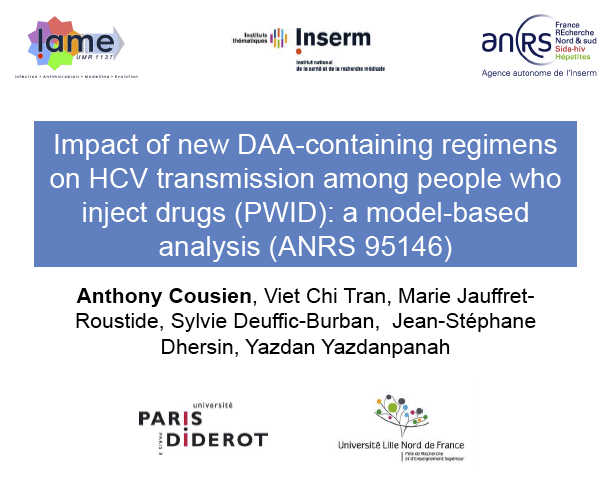
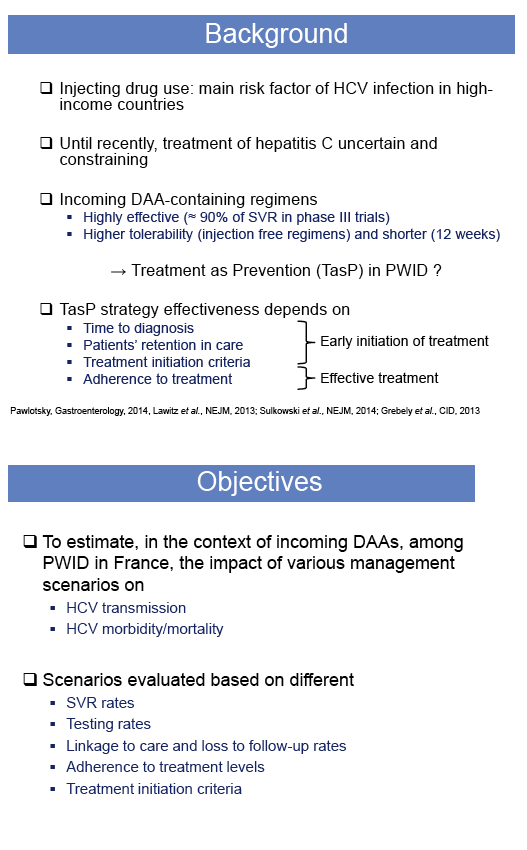
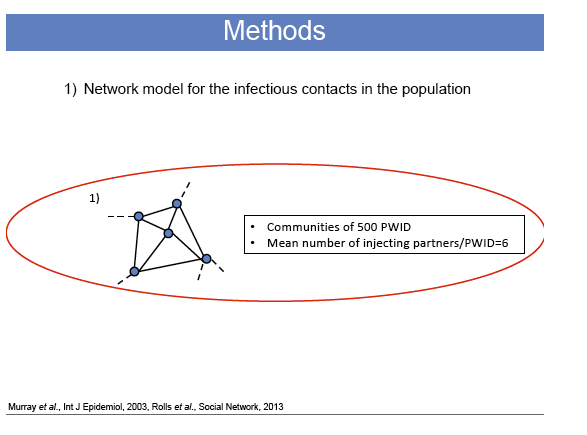
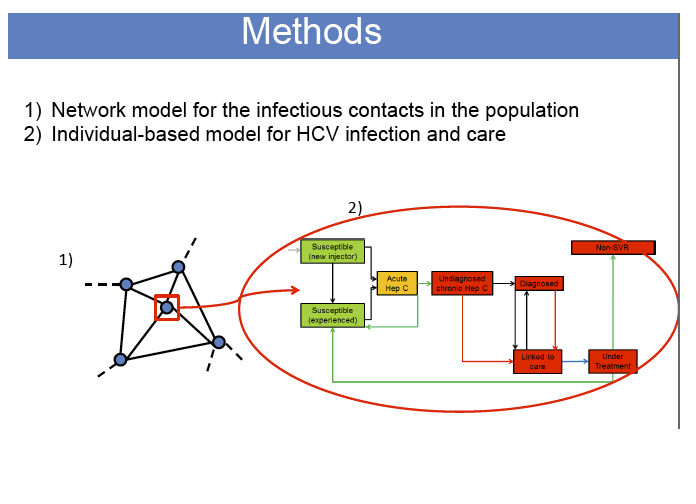
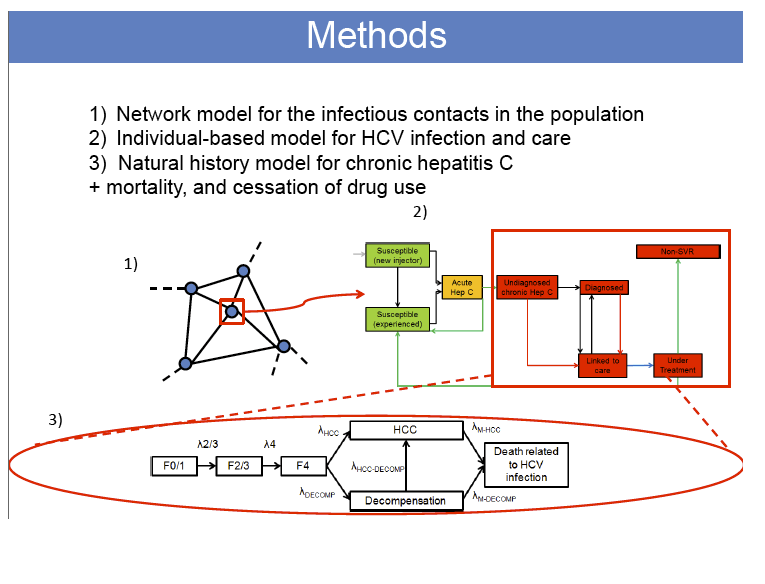
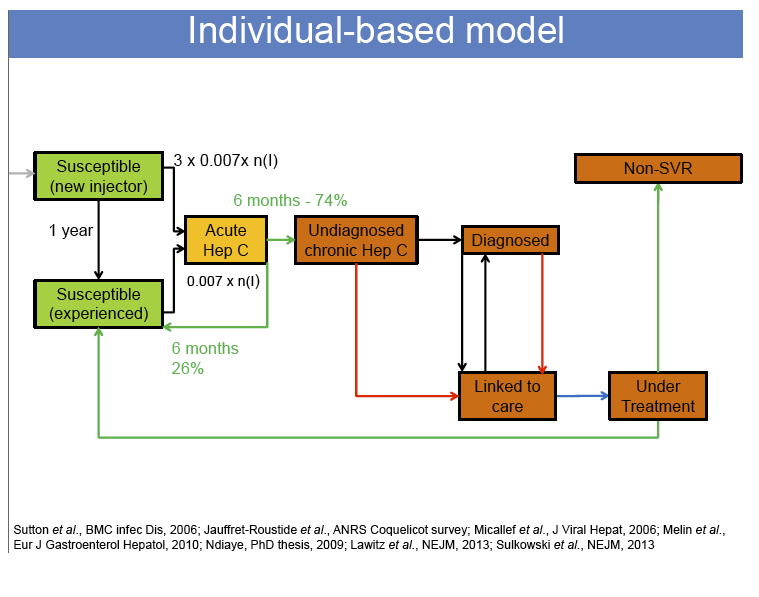
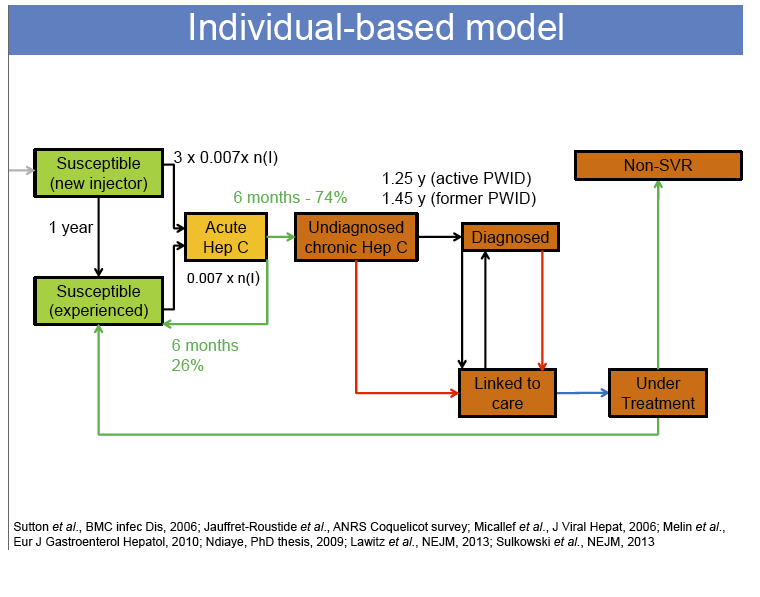
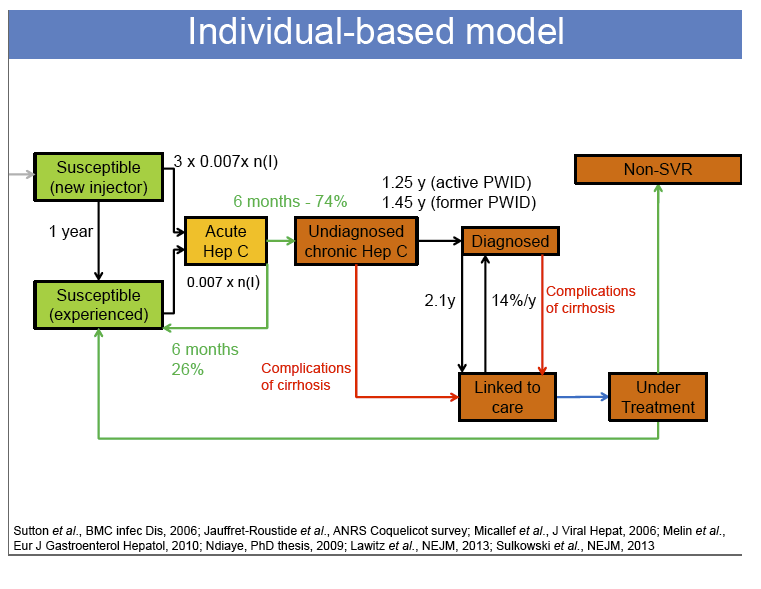
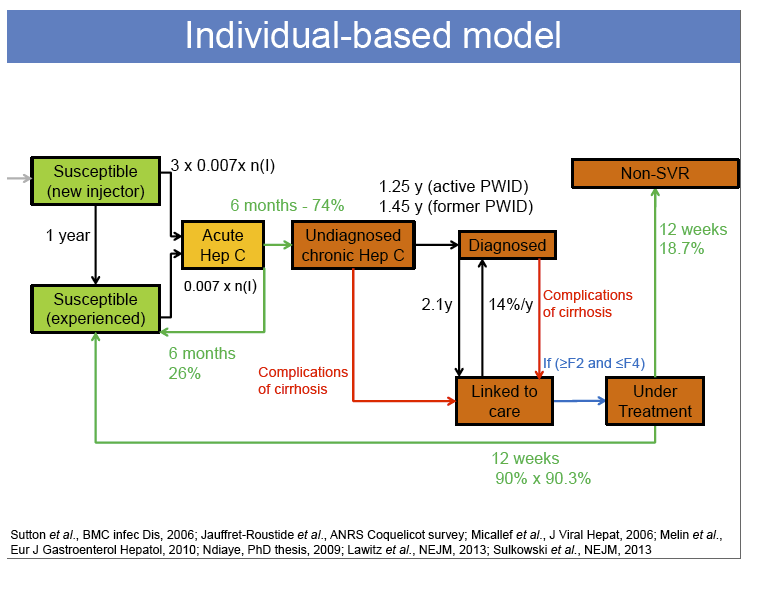
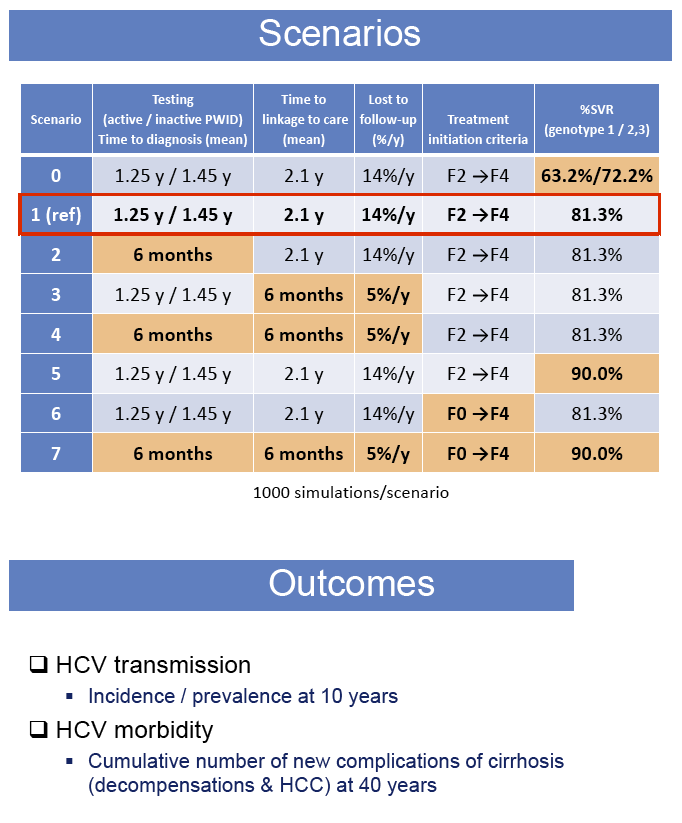
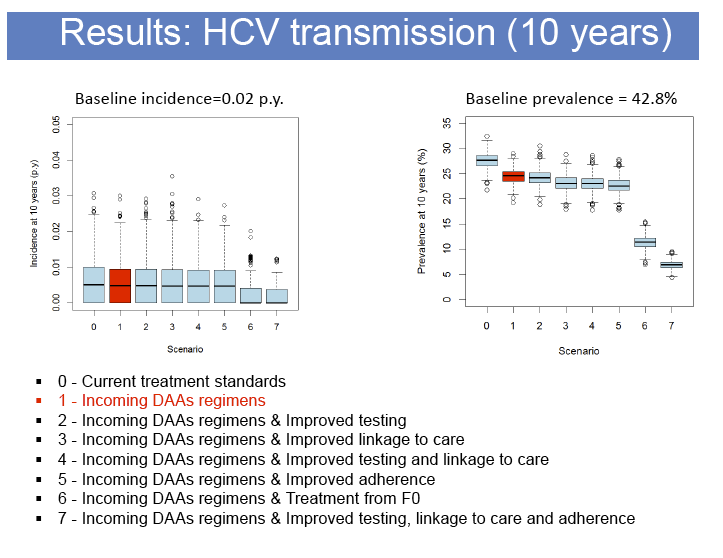
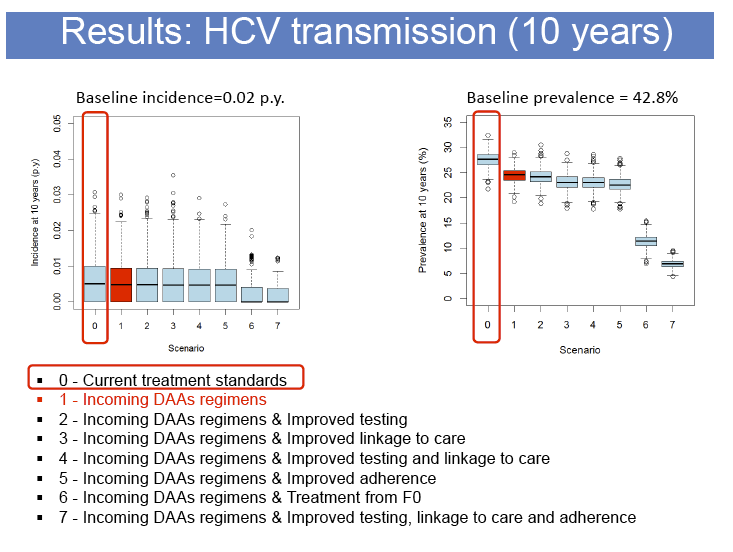
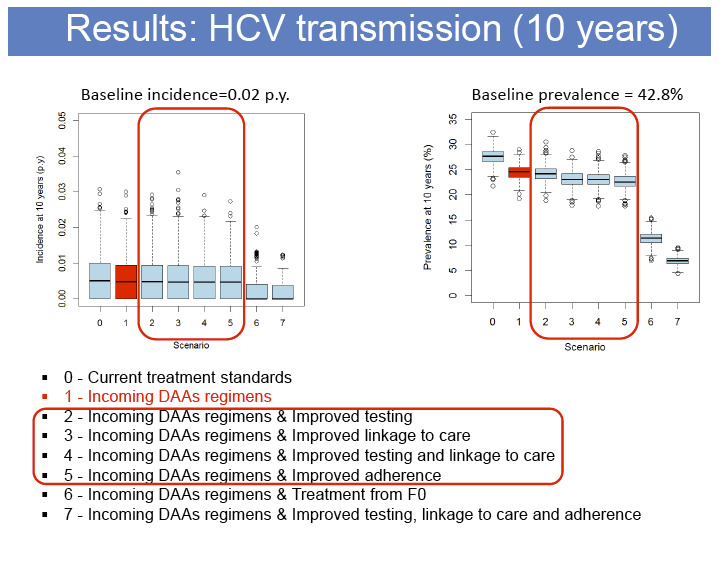
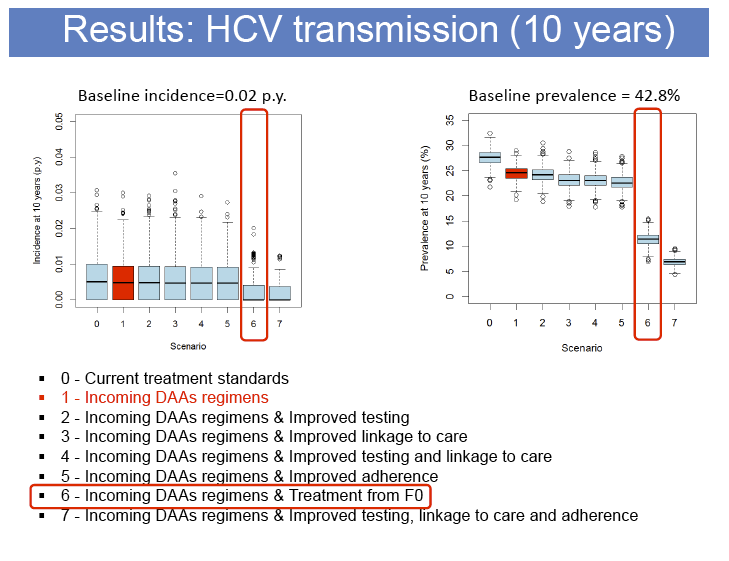
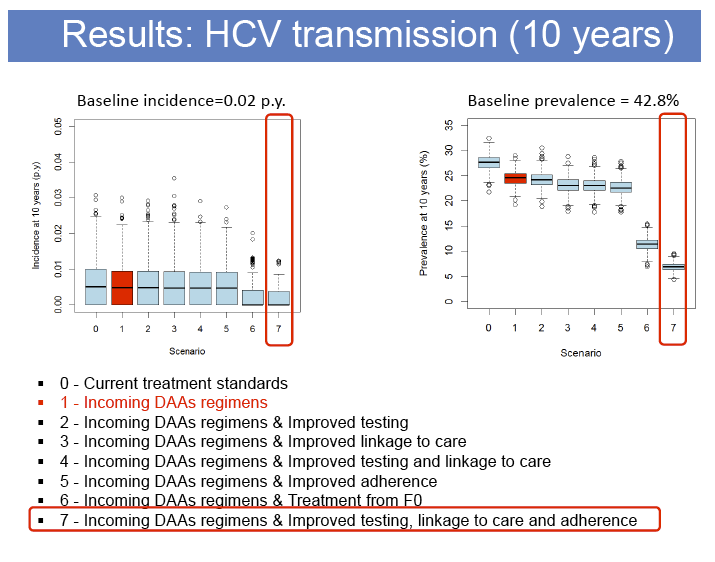
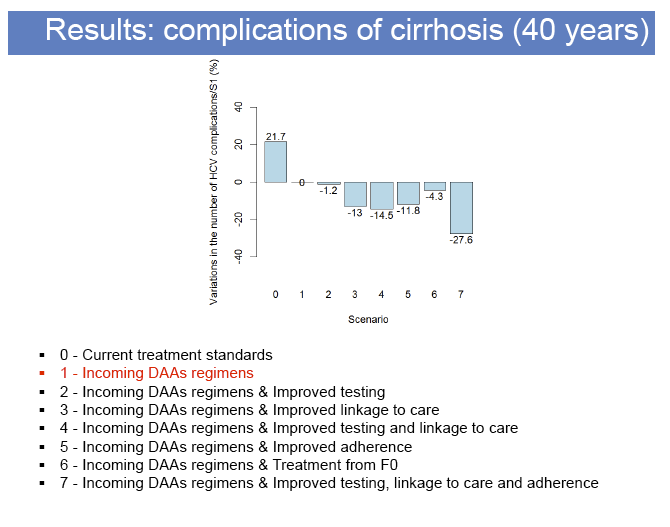
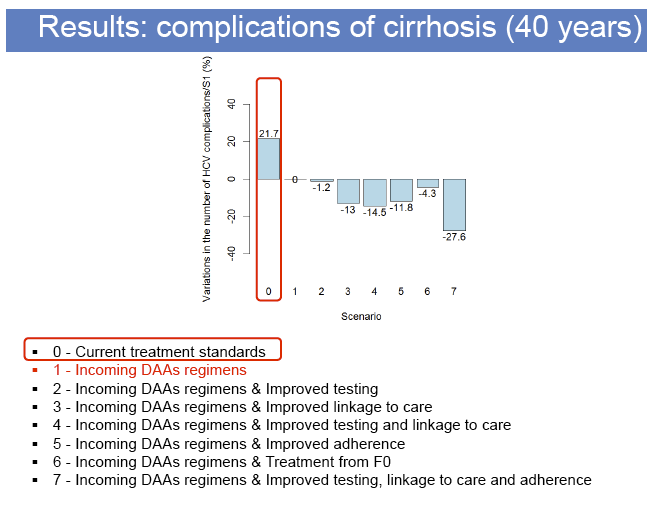
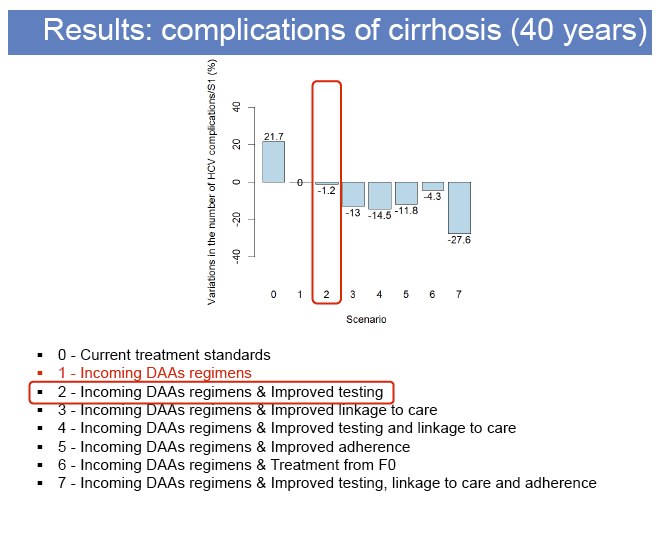
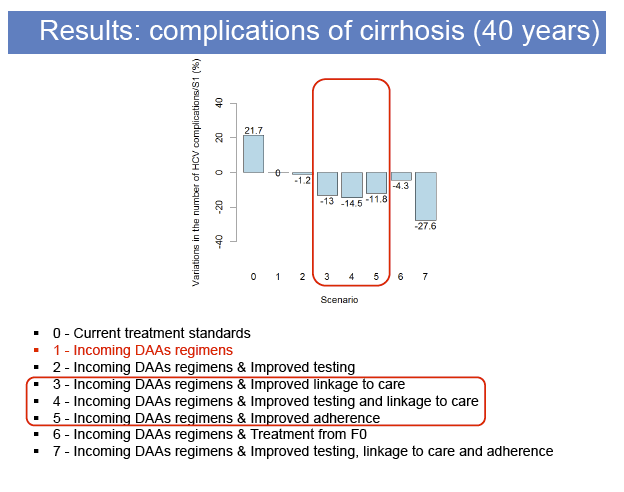
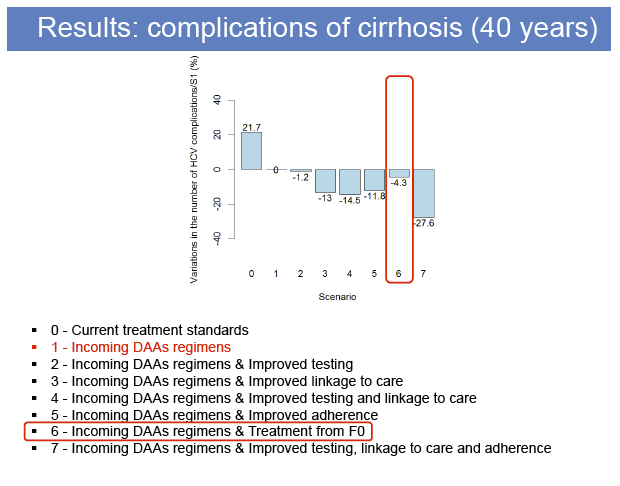
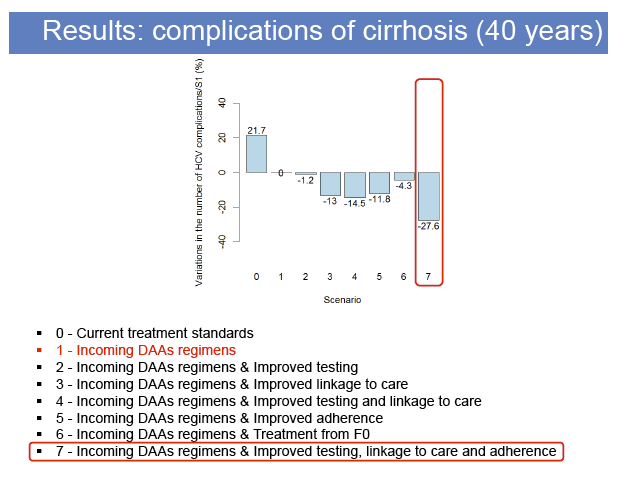
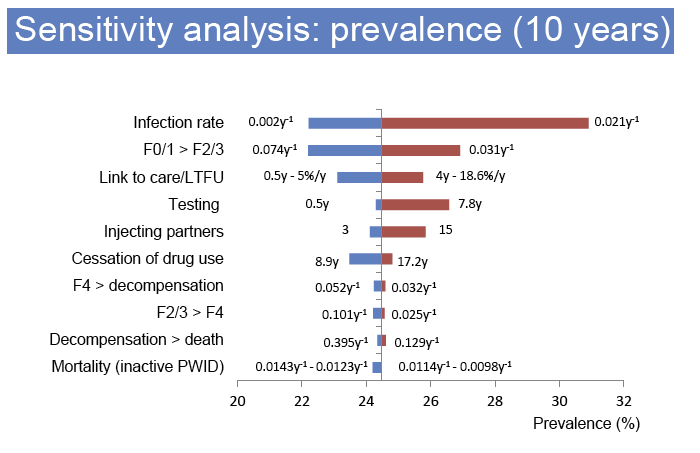
From the authors:
For the sensitivity analysis, slide 34/35 : this is the variations of the prevalence at 10 years obtained by varying the parameter values in an uncertainty range or with data from other countries. The results are not really surprising: infection rate is the most sensitive parameter, followed by the transition rate between F0/F1 and F2/F3 and the access to care rates (which determine the treatment). However, in our main analysis, an improvement of testing led to no real decrease of prevalence, but here, for a value of 7.8 years (corresponding to the situation in UK), we obtained a 2.3% higher prevalence. Similarly, for the variation of the number of complications after 40 years (slide 36), we obtained 10% of additional complications. These results show that in other countries, an improvement of testing could impact the prevalence/the morbidity.
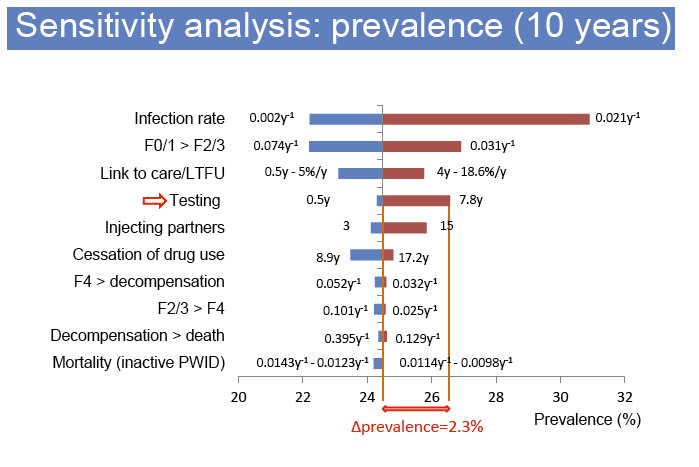
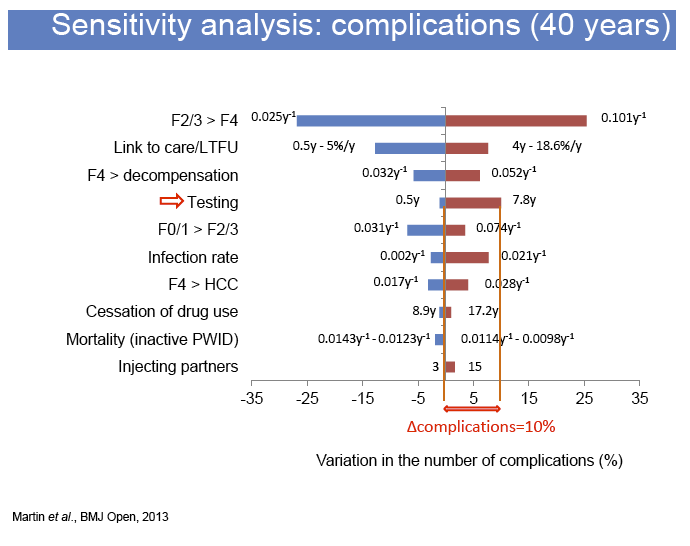
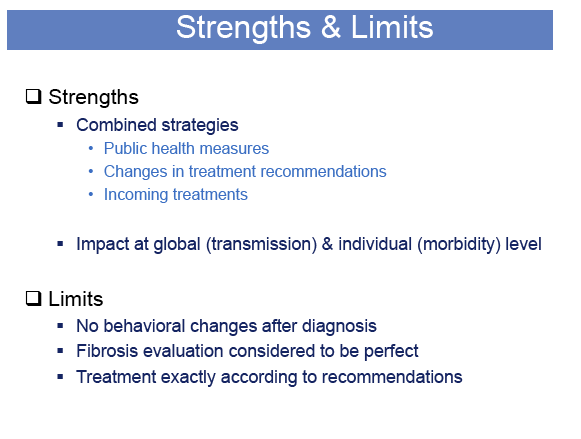
|
| |
|
 |
 |
|
|